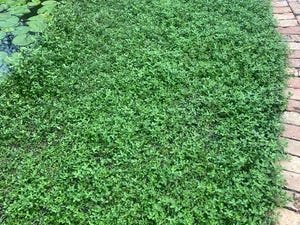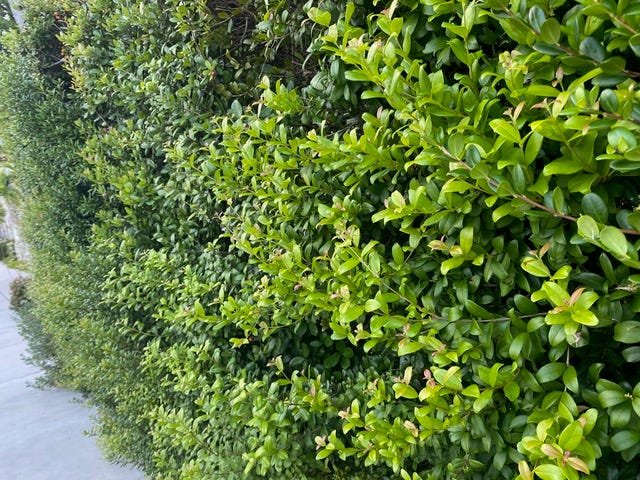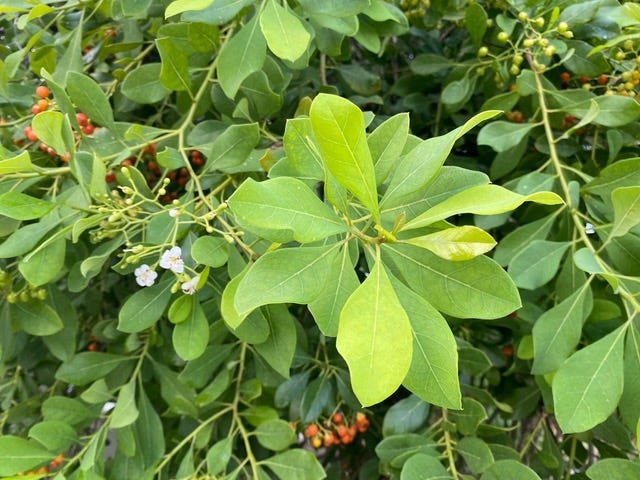Green gardening: Let's not poison paradise
Sunshine mimosa is a fast grower with deep roots that is drought-and salt-tolerant and even be mown
November 28, 2020
The Age of COVID has brought about a dramatic Co2 reduction in the atmosphere as less engine exhaust from auto, air, and water travel translates to less pollution in our sky, rivers and waterways.
The air is cleaner as more people are walking, biking and recreating outside. But with this reduction in emissions pollution, let’s not get too complacent about our gardens and their attendant chemical “requirements.”
Excessive use of nitrogen fertilizers in chemical intensive agriculture has driven global N2O (nitrous oxide) emissions higher than ever projected. Additional use of nitrogen-laden fertilizers by homeowners exacerbates the problem.
If your lawn is healthy, it has no need for added fertilizers, which encourage fast, weak root growth, and invigorate the weeds you’re looking to eliminate. The fertilizers, herbicides and fungicides recommended by your lawn services will eventually end up in our lakes, rivers and drinking water, resulting in red tides and algae blooms, not to mention neurological disorders and cancers in our children and pets, and ourselves.
I’ve talked about lawns before but here’s a reminder on how to maintain sustainable “green” lawns without toxic chemicals.
First, water less frequently but with greater depth. Encouraging grass roots to search deeper into the soil for water will make them longer, stronger and less likely to dry out.
Weed roots tend to be shallow, so lightly watering every few days encourages grass roots to stay near the surface and compete with the weeds. It’s no secret which will win that battle. If the top few inches of soil are bone-dry, the weed seedlings will die, while the more deeply rooted grass will find moisture below.
Moreover, irrigating lawns accounts for up to 60% of our residential water consumption and washes away valuable nutrients in the process. Less water is better for your lawn and your pocketbook.
Second, mow on the high side, never removing more than one third of the grass blade. Longer blades convert sunshine into sugar (remember photosynthesis?) to feed and encourage a stronger root system. Taller grass is healthier and thicker, stifling weeds and shading roots so they need less water. And leave the clippings; these act as mulch, adding nutrients to the soil while preventing evaporation on hot days.
Finally, understand your soil. Healthy soil supports countless microorganisms that provide nutrients essential to healthy grass and plants resistant to pests and disease. These microorganisms hate salt, which is a primary component of all chemical fertilizers.
Chemical fertilizers begin an endless cycle by killing these beneficial microorganisms that would otherwise nourish the soil, so you have to keep fertilizing. Chemicals in our lawn care products are toxic to birds, insects, children and pets. The herbicide 2,4-D, a component of Agent Orange, is used in more than 1,500 lawn products that are readily available at home and garden stores.
Lawn alternatives
If your grass just isn’t doing well and you need to do something, consider reducing the size of your lawn area and using a ground cover instead. Here are some suggestions.
If you have sun, native frog fruit, Phyla nodiflora, and sunshine mimosa, Mimosa strigillosa, make excellent substitutes.
Frog fruit makes a better ground cover than lawn grass because it withstands foot traffic as well oe better, while needing far fewer treatments to keep it healthy
Frog fruit, also called creeping Charlie, is the larval host for the white peacock butterfly and provides nectar for crescents, blues, hairstreaks and metalmarks. This actually makes a better groundcover than lawn grass and withstands foot traffic while providing tiny white to pink flowers that add a festive sparkle.
Frog fruit also adds color to the lawn with its tiny white to pink flowers
Sunshine mimosa is another excellent groundcover for full sun. Forming a dense mat of bright green fernlike foliage, this is tough enough to withstand light traffic.
The powderpuff-like flowers of sunshine mimosa provide food for manu types of butterflies
The bright pink powderpuff-like flowers stand above the foliage with charming effect and the linear leaflets close up when touched, delighting children of all ages and earning it the nickname "sensitive plant."
This is a fast grower with deep roots that protect against soil erosion. Once established, it is drought and salt tolerant and can even be mown. On top of all these excellent credentials, it is the larval host for the little yellow, a tiny butterfly flying low to the ground, while providing nectar for many other butterflies as well.
River sage, with its deep green foliage and blue flowers, is a good ground cover choice for shady areas
If you’re dealing with shady areas, native river sage, Salvia misella is a great choice, with robust mounds of deep green foliage beneath shoots of tiny azure blue flowers.
While you’re deciding not to add chemicals to your lawns, consider not spraying toxic pesticides on your hedges and shrubs.
Those elegant walls of ficus are an integral part of many classic Palm Beach landscapes, but we all need to appreciate the connection between the chemicals we use in our yards and gardens and the overall health of our environment.
Bikers, walkers and babies in strollers along the Lake Trail are consistently bombarded with excess spray from “environmental” landscape companies treating these hedges. Aside from the terrible smell, these chemical cocktails usually contain imidacloprid, a systemic neonicotinoid that paralyzes the insects’ nervous system. As a systemic, it travels throughout the plant’s roots, stems, leaves, fruits and flowers, making every part of the plant poisonous.
Imidacloprid can last for months or years in the soil, and it leaches into groundwater where it is toxic to fish – and we get to drink it as well! Toxic to birds, beneficial insects and pollinators, it has been linked to the Colony Collapse Disorder decimating our honeybee populations. It is listed as hazardous to domestic animals and humans where it has been linked to neurological and reproductive disorders.
Other highly toxic chemicals widely used by Palm Beach “environmental pest controls” are acetamiprid, bifenthrin, and glyphosate the latter found in the weed killer Round Up and now widely accepted as a known carcinogen linked to Alzheimer’s, autism, leukemia, non-Hodgkins lymphoma and other cancers. There’s no rational reason for us to be spraying this stuff on our properties. There are many biological, eco-friendly alternatives to chemical sprays and drenches that won’t harm the native beneficial insects and predators necessary to control unwanted infestations.
Hedge alternatives
Planting natives will also eliminate the need for chemicals, while supporting the insects vital to birds and a vast percentage of the world’s fauna.
There are wonderful native hedge alternatives to replace ficus.
Simpson’s stopper is a great hedge plant for areas with full sun to part shade, growing to 25 feet and tolerating a variety of soil conditions
Simpson's stopper, Myrcianthes fragrans, is one of the best, performing well in full sun to part shade, growing to 25 feet and tolerating a variety of soil conditions. Its dark green, leathery leaves are aromatic when crushed, and the small white flowers are fragrant as well. Mockingbirds, catbirds, and cardinals love the bright red berries.
Wild Coffee makes another terrific hedge, growing to 8 feet, with beautiful dark green glossy foliage
Wild coffee, Psychotria nervosa, makes another terrific hedge, growing to 8 feet, with beautiful dark green glossy foliage. A dwarf form, growing to 2 feet, is ideal along walkways or under windows. Clusters of small white flowers attract numerous butterflies, including the ruddy daggerwing, and the bright red fruits are a favorite of mockingbirds and catbirds.
Bahama strong back is a fast grower that creates a tall dense screen in sun or partial shade
The fast-growing Bahama strongback, Bourreria succulenta, creates a tall dense screen in sun or partial shade. Growing to 16 feet, its clusters of small white fragrant flowers attract butterflies and hummingbirds; the small, attractive orange fruits provide food for numerous birds and small mammals. Vireos, warblers and flycatchers search the canopy for insects attracted to the blossoms. You’re helping everyone when you plant this tree!
The small orange fruits of Bahama strongbark provide food for numerous birds and small mammals
In short, don’t let landscaping companies convince you that your plants will suffer if they aren’t chemically treated. Plant natives and your landscape will thrive as the beneficial insects and microorganisms that nourish the soil are re-established, and birds and butterflies (and hummingbirds!) return to your garden.
-Kim Frisbie
Original article on the Palm Beach Daily News is HERE.









